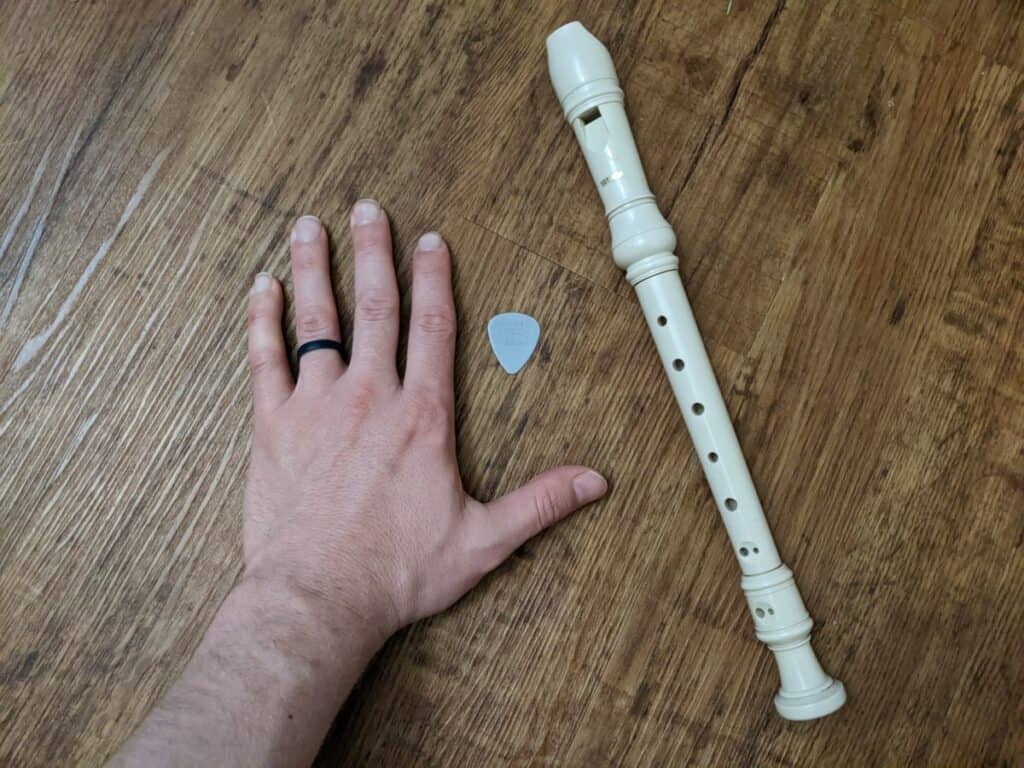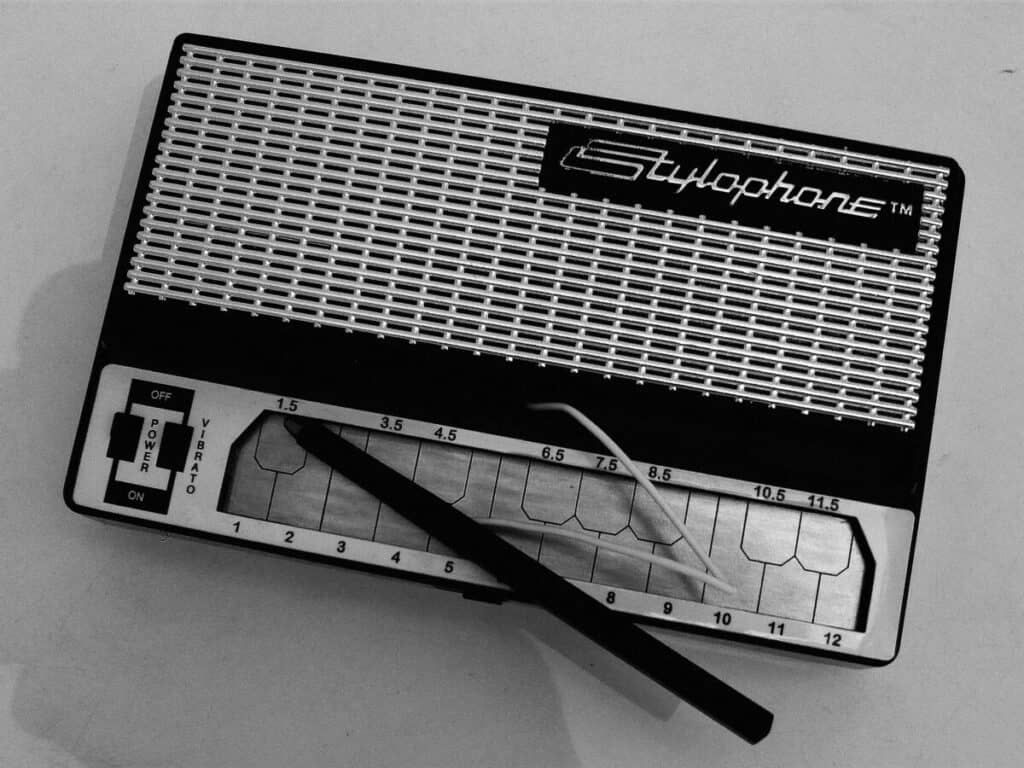This post contains affiliate links. We earn commissions if you purchase products from retailers after clicking on a link from our site. As an Amazon Associate, we earn from qualifying purchases.
Are you interested in small, portable instruments you can carry everywhere? Look no further! I’ll try to put in the most important and recognizable instruments that you shouldn’t have trouble finding if you want to get one for yourself.
I have many of these instruments! So I took pictures of whatever I could. Otherwise I found what images I could so you can see what these instruments look like.
Melodic
Harmonica
The harmonica is an incredible instrument. You might hear me say this a lot, but I actually spent over 30 hours practicing the harmonica in 30 days a while back, and I learned that the harmonica has incredible variety in sound and pitch modulation.
You can bend and pull notes and so many rhythm and tone variations you can make.
You can blow in one side of the instrument to make reeds inside the harmonica flutter which makes the sound.
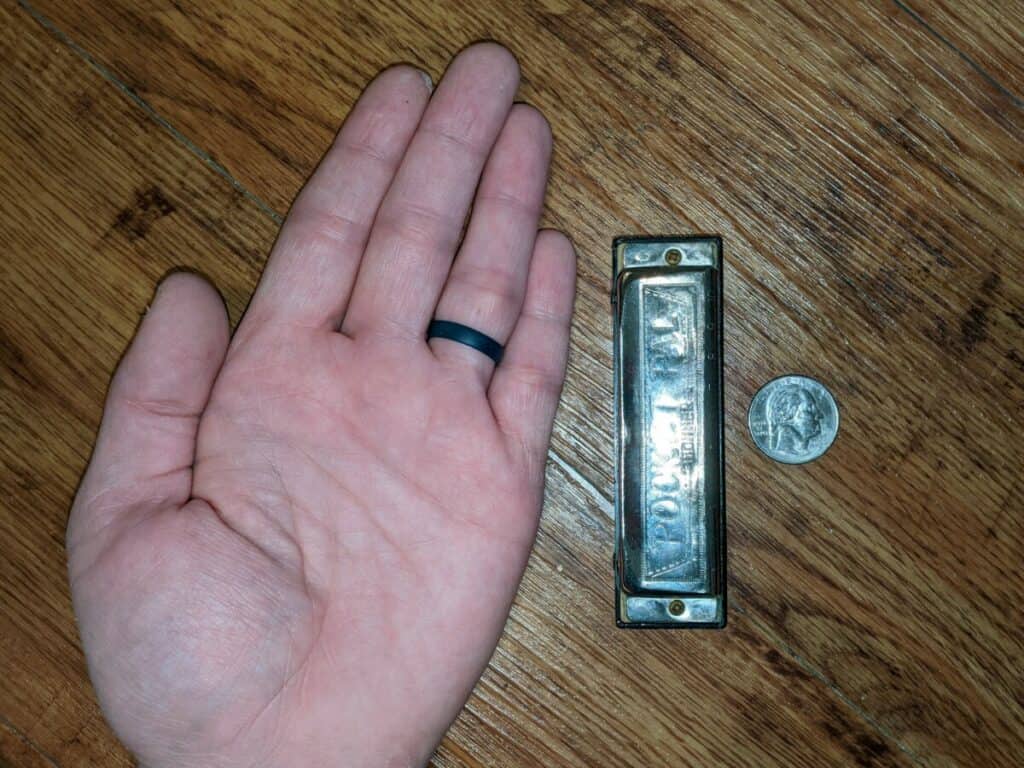
By the way, looking for recording equipment and musical instruments? Check out Sweetwater.com for microphones, monitors, audio interface or any other recording gear that you could ever need. (Affiliate Link)
Some people spend their entire musical careers on the harmonica. It’s a serious instrument with serious potential.
Jaw Harp
The Jaw Harp is not quite melodic, but not quite rhythmic, but rather a mix of both.
The jaw harp is a metallic frame that has a small reed that passes in between your teeth making a weird twanging sound.
To play the jaw harp, you press the jaw harp against your teeth with your teeth slightly apart, and push the reed and release to make the twanging sound.
I love the jaw harp and have spent many hours playing this beautiful if not strange instrument.
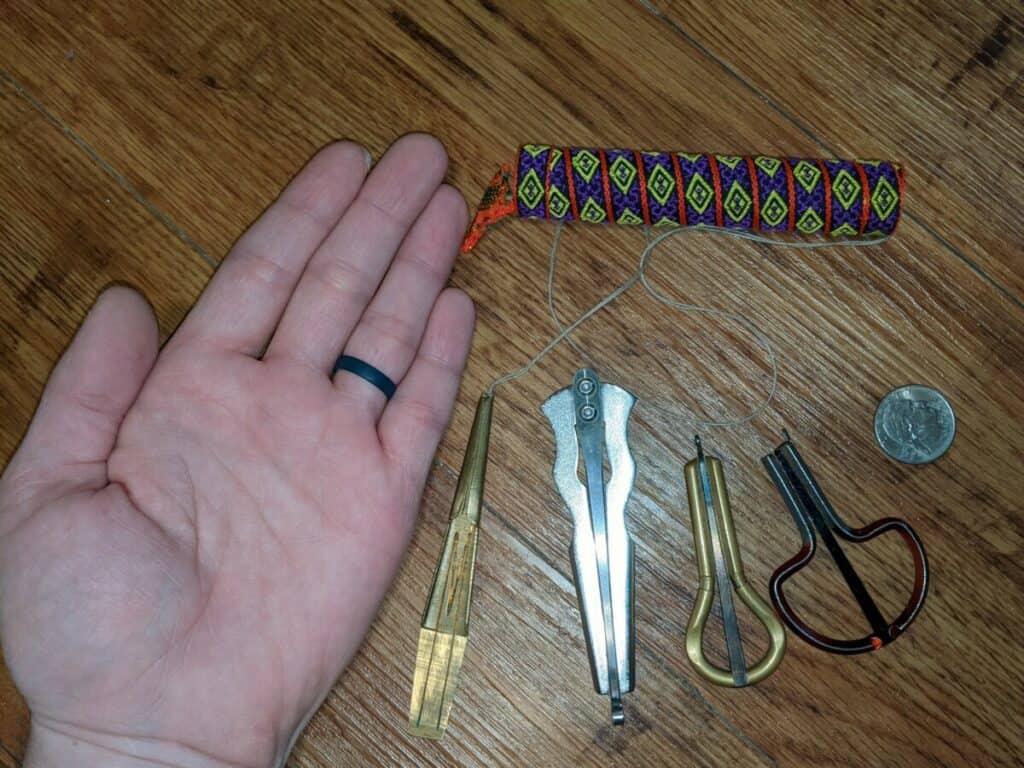
By the way, if you want to learn how to play the jaw harp, I cover that in detail with pictures (and video, if you prefer). Make sure to check that out, here.
Dan Moi
The Dan Moi is very similar in sound to the jaw harp but is markedly different because instead of pressing the metal frame against your teeth you press it against your lips. You can see an example of what it looks like in the image in the jaw harp section.
There are many different sizes of Dan Moi, but several fit within the palm of your hand. Be careful with the Dan Moi, the reed has very sharp edges.
Train Whistle
The train whistle is more of a noisemaker than a serious instrument, but you’re sure to find it in some musical pieces that have a specific novelty sound effect. So… why not, let’s count it!
And… I know we have one, I just can’t find it… so no picture. 😢
Ocarina
The ocarina is a type of flute where instead of being a long and thin cylinder, it’s more of a vessel with holes strategically placed to make certain tones.
Ocarinas come in every sort of size, some ocarinas are very small, and others are fairly large.
To play the ocarina, you blow air into one side of the instrument and use your fingers to cover or uncover the holes to change which notes to play
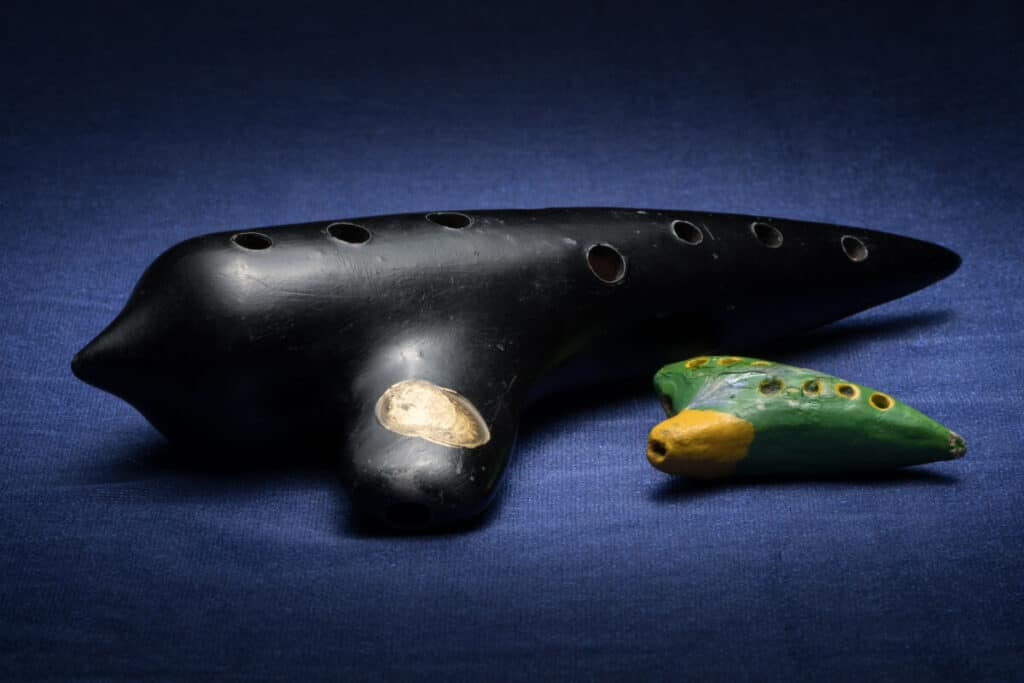
If you’re looking for a small instrument you can fit in your pocket and that can play melodies with, an ocarina is actually a pretty solid choice.
Slide Whistle
The slide whistle is more of a toy instrument, but it is small, and it does play multiple notes.
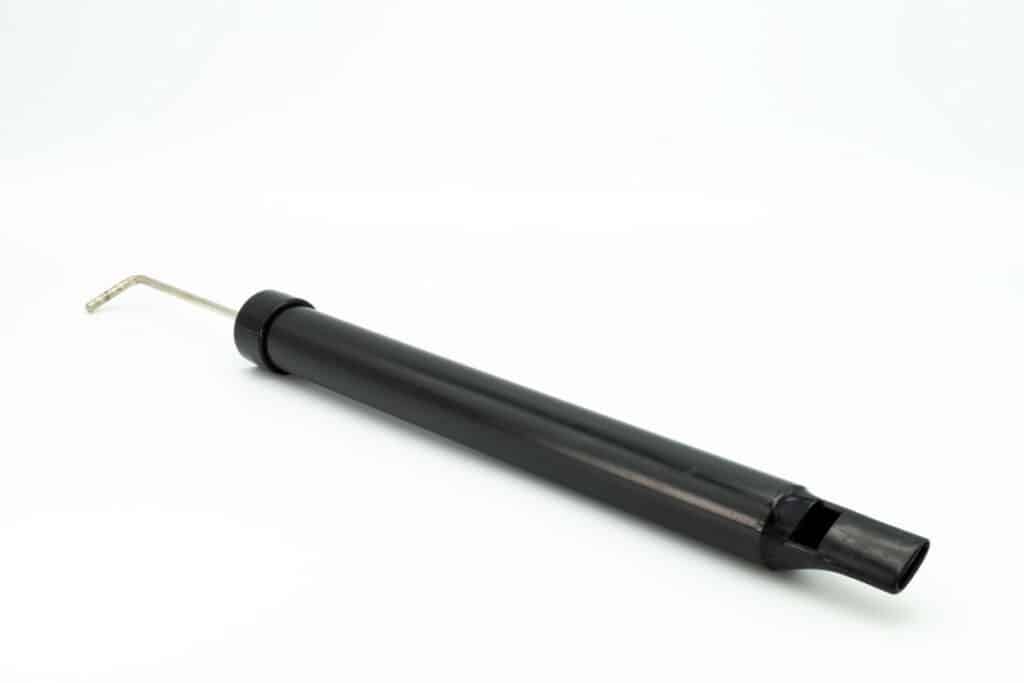
The instrument works a bit like a trombone in that you can change the size of the cavity while blowing through the fipple (mouthpiece) to create the sound.
Slide whistles can fit in your pocket, with no problem, and they are either plastic or wood.
Triangle
The triangle is featured in orchestral pieces and is tuned to a specific note. Using a striker, you hit the triangle to make it resonate (making this an idiophone).
Because the triangle is tuned to a specific note, an orchestra may have multiple triangles for different notes depending on the needs of the song.
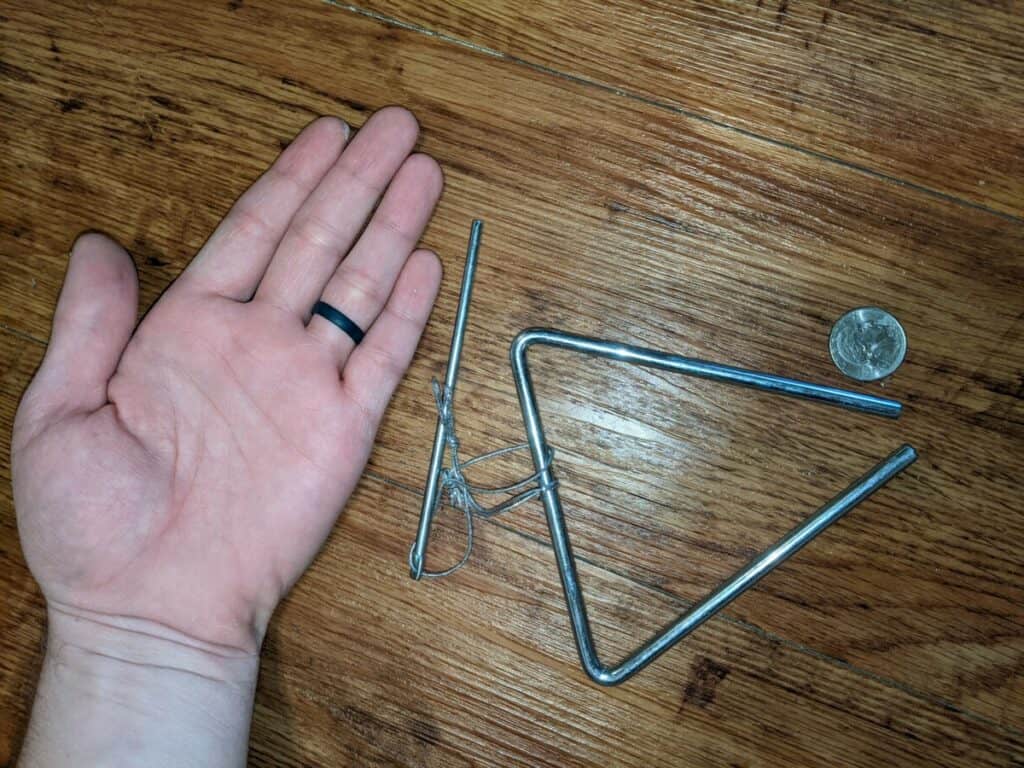
Kalimba (Thumb Piano)
There are about as many types of kalimbas as there are shades of blue. Some kalimbas are huge, while others are pretty small. You can get a 21-key kalimba that’s about a hand’s length.
The kalimba is made up of metal tines tuned to specific notes (which you can actually manually tune, yourself, by changing the length of the tines).
You play the kalimba by plucking the tines with your thumbs (but you can use your fingers).
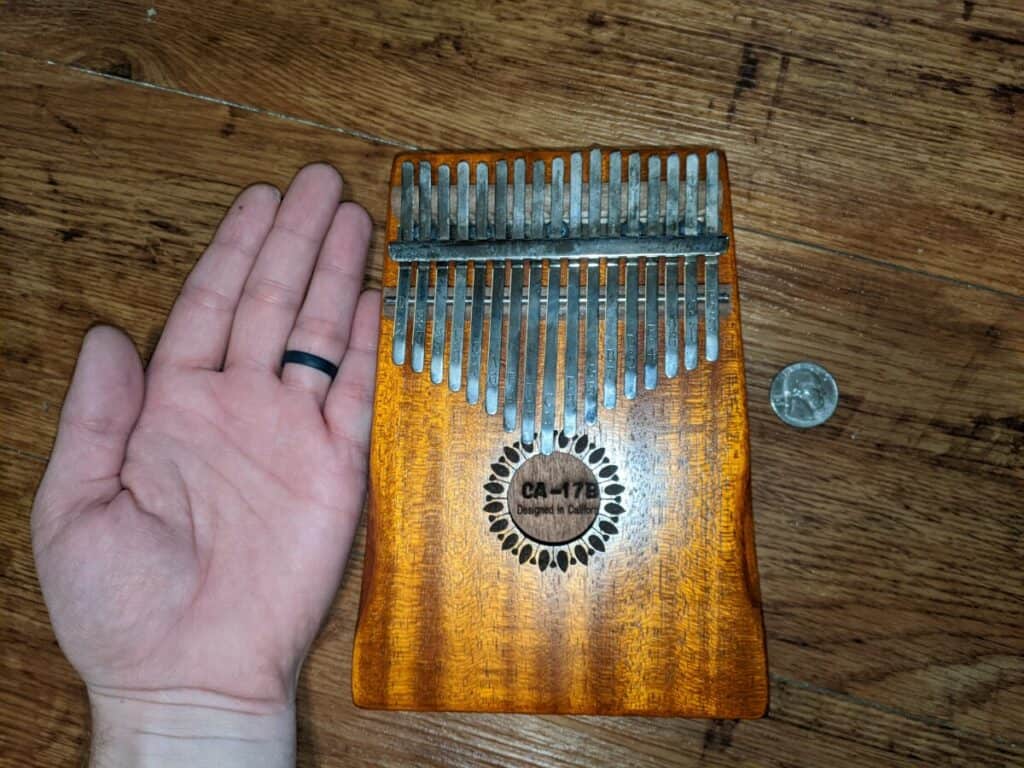
If you want to see a demonstration of the kalimba as well as how to play it, make sure to check out my video, here:
Music Box
You’d be absolutely amazed at how small a music box can actually be. It works much like a Kalimba, in that metal tines are plucked by a programming wheel that is turned by a crank.
A music box is kind of an instrument, in that it plays music, but it is only tuned to one melody that repeats forever.
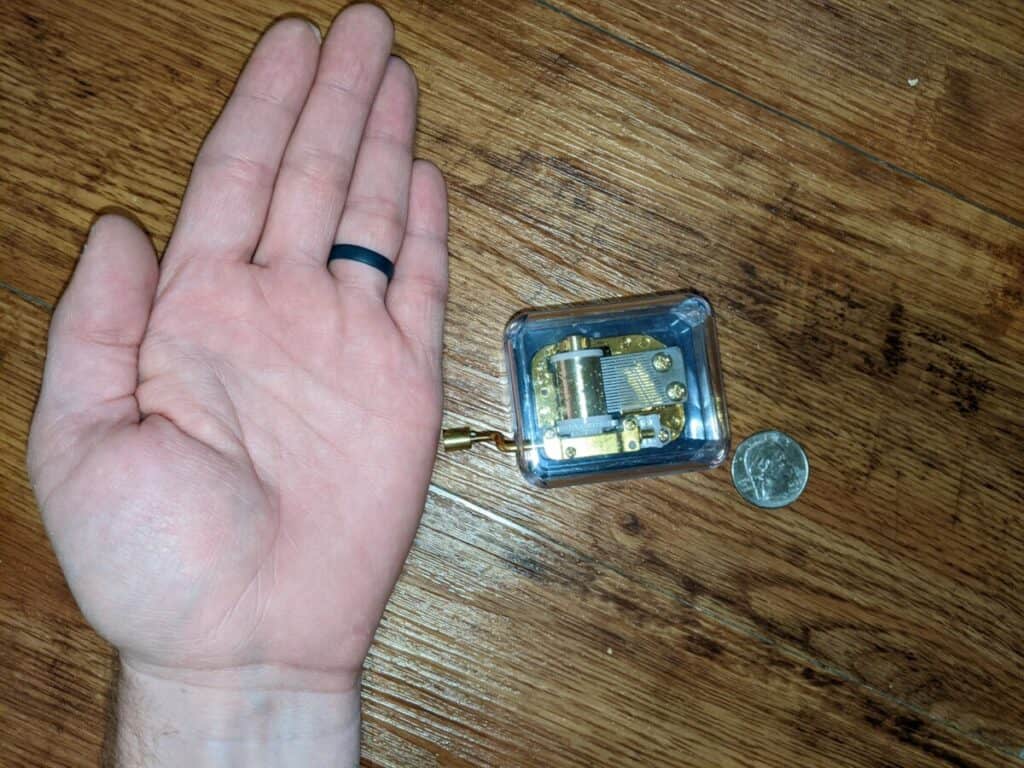
We’ve actually fallen in love with these music boxes–we have three of them! They’re great gifts for little kids. In fact, my sister has autistic kids that are older and they love them as it gives them a sense that they are involved with playing the music.
You can find these music boxes on Amazon, here.
Piccolo
The piccolo is a serious instrument. Although most players of the piccolo also play the concert flute, some piccolo players (such as in military bands or marching bands) play the piccolo full-time.
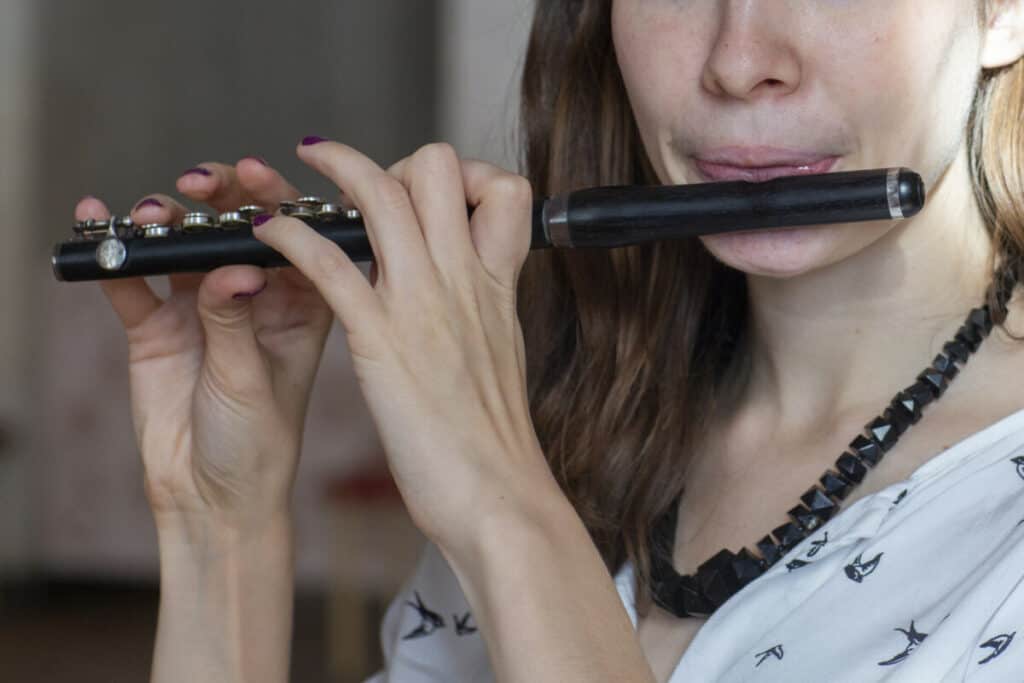
The piccolo is very similar to a concert flute except much smaller. Because of its size, the piccolo is designed for playing in very high registers.
This means that you shouldn’t sit too close because piccolo players can play very loud and high so they can carry their sound on top of the entire orchestra.
Handbell
Another Melodic Idiophone, the handbell is a very simple instrument, and while you can technically fit one of these handbells in your pocket, you wouldn’t have much of a melody if you just have one of them.
If however, you have 6 others with pockets, you can play an entire scale!
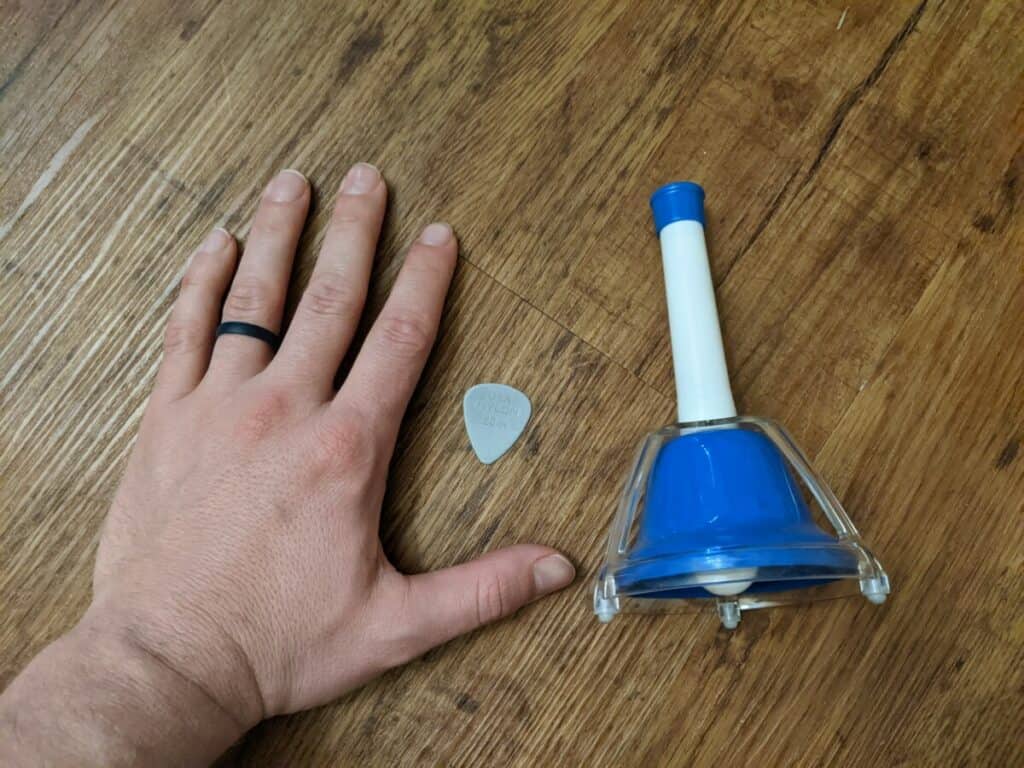
You can find an entire set here on Amazon, here.
Orba
The Orba is a synthesizer and is capable of playing melody and percussion. You can use it as a shaker with its built-in gyroscopes and accelerometers, you can tap it to play drums, or you can play melodies as you rub the surface of the Orba.
If you’re talented you can put all of it together in loops to play songs with an instrument that fits in the palm of your hand.
You can find one of these on Amazon, here.
Stylophone
A stylophone is a synthesizer you play with a stylus.
Yep, that’s right.
You play the instrument by moving the stylus up and down across the contact area on the bottom right of the instrument. The entire instrument is actually pretty small and a fun way to scratch out a melody when you’re taking a break from your homework.
You can still get these on Amazon, here.
Tin Whistle
The tin whistle is one of my favorite instruments. It’s diatonic, meaning it’s tuned to play just a single scale, but you can get multiple tin whistles if you want to (more easily) play all the notes.
To me, there is astounding versatility and beauty in the instrument. I could just noodle on it forever if I could.
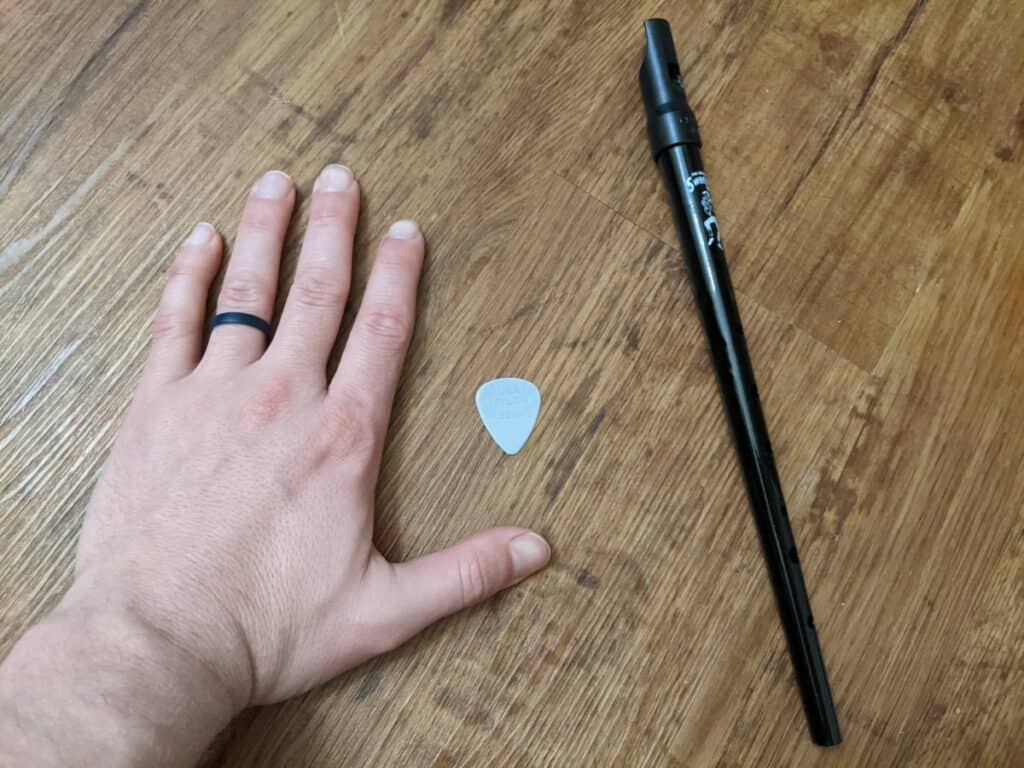
In comparison to other instruments, a tin whistle can be delightfully small, and can fit in your pocket (at least vertically). This is my personal instrument of choice if I want to play a melody on the go.
Kazoo
The kazoo is one of the few melodic membranophones (I know of only two, to be honest), where the sound is made by a vibrating membrane.
The kazoo is considered a toy instrument.
To play the kazoo, you vocalize through your mouth to make the vibration (like humming with your mouth open).
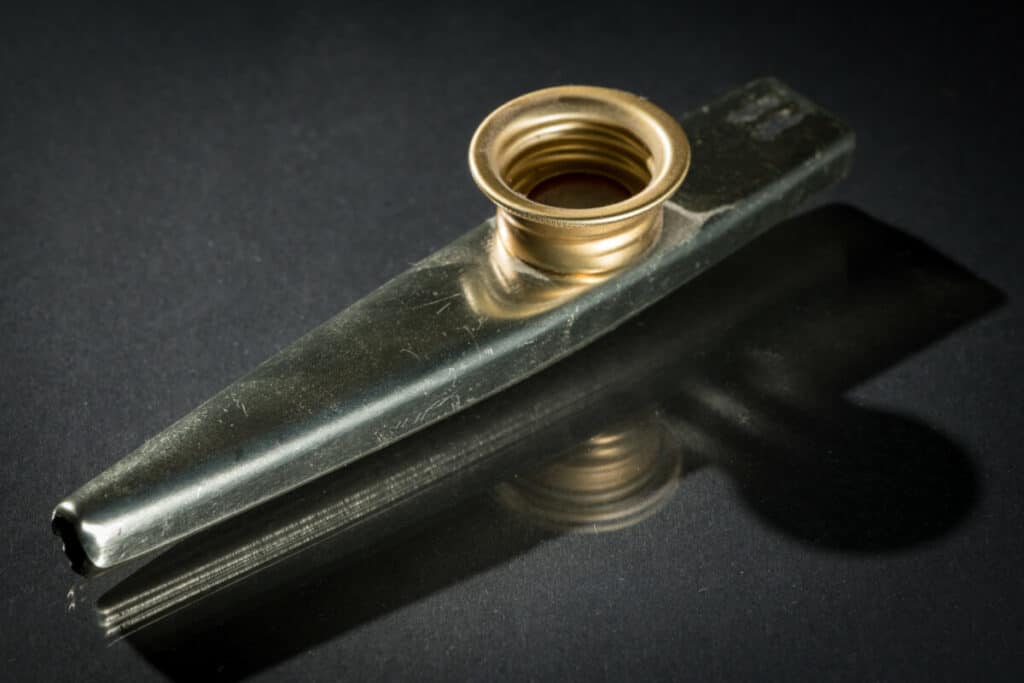
Small Theremin
The theremin is an incredible instrument that works via electromagnetic interference (similar to an electric guitar), except it’s contact free.
Many theremins are meant to be used while standing and are fairly large (almost 2 feet across), but there are some cheaper designs that are fairly tiny, like this one (Amazon), that can fit in your pocket.
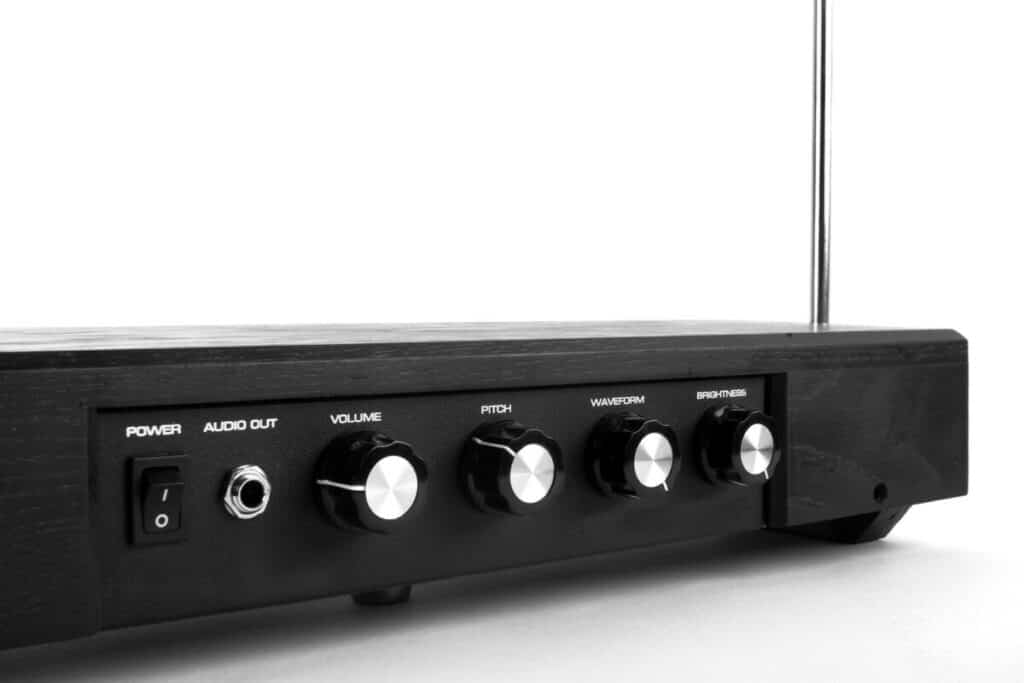
To be fair, though, even if you can find a small theremin, you have to find something to project the sound–so some sort of speaker you can hook the sound up to like an amplifier or other speaker.
Percussion / Rhythmic
Bones
The bones are an ancient instrument–about as long as humans have eaten meat. The bones are called bones because you can bang cow ribs together.
If you don’t want to literally play bones, you can use pieces of woods (called bones) that are carved to be held in between your fingers similar to traditional bones.
Bones are actually not easy to just pick up and play, there’s an indescribable knack that you have to practice for a couple hours to get a hang of.
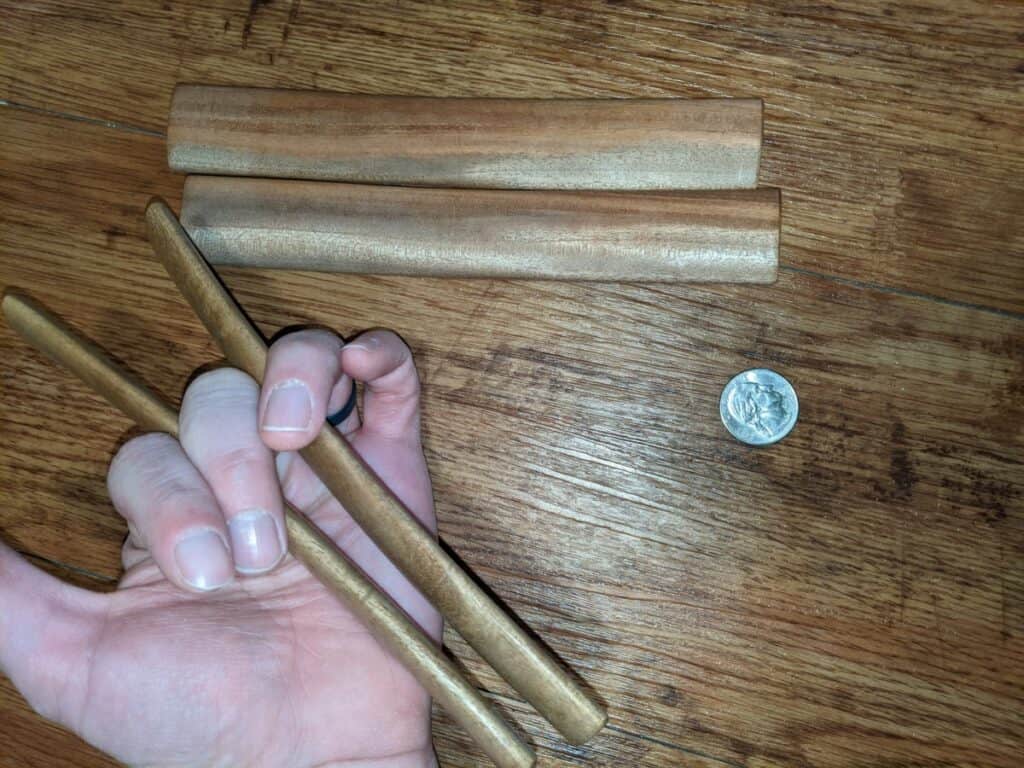
Don’t be fooled–even though the bones can fit in your pocket, they can make a tremendous amount of sound. I actually like to practice with earplugs because my ears get tired of it.
Spoons
The spoons are played similarly to the Bones, and you can use normal spoons if you figure out the knack, but often spoons players will play with a type of jig holding two spoons you normally wouldn’t eat with.
Musical spoons can be made from wood, metal, or plastic.
These are tough to find, but you can find some on Amazon, here.
Egg or Handheld Shakers
There are many types of percussion instruments that are built on one principle: a bunch of small granules of something hitting wood and crashing together.
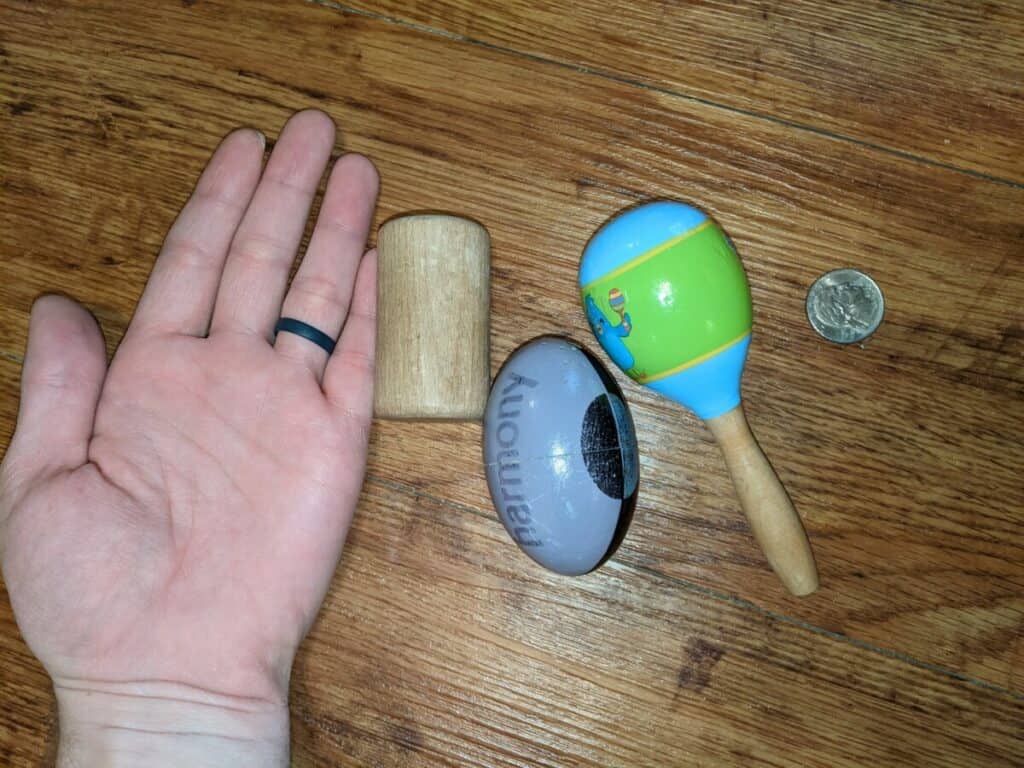
Egg shakers are my personal favorite because they can easily be held in the palm of your hand and they can add that little “somethin`” to the music you’re playing to.
Maracas
A maraca is a type of shaker but it has a handle you can hold the instrument by to shake.
Maracas can be huge, actually, but they also can be small. Some are plastic and some are wood, and they all sound different from one another.
Similar to shakers, the sound of the maraca can vary from set to set because of the size of the pellets inside. Some of them use rice, little ball bearings, or even some use beans. All of these change the sound and how you play them as well as which songs they fit with.
Castanets
Castanets are essentially two concave surfaces that you clap together to play. Castanets can be wood, metal, or plastic.
Castanets can be played with one hand or with two pairs in both hands.
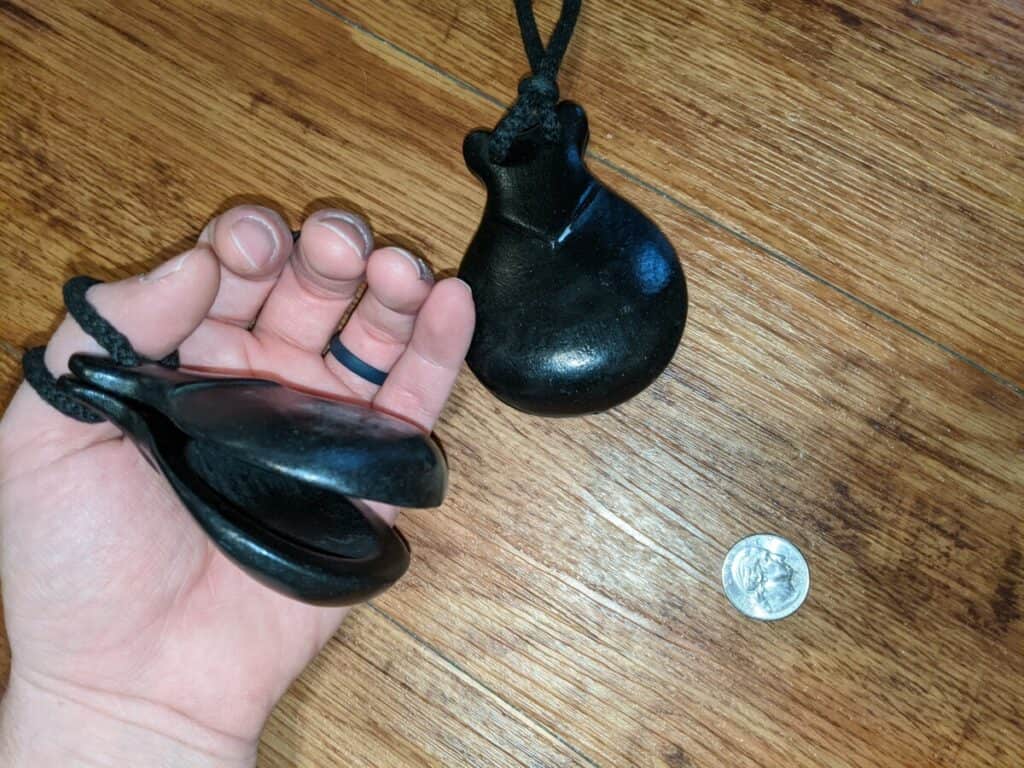
Playing the castanets takes a tremendous amount of inter-digit independence.
Sleigh Bells
You’ll see a lot of variation on the sleigh bell, but essentially a sleigh bell is anything where you have a piece of metal enclosing a ball bearing that you shake around. Just imagine Santa Clause approaching and you’ll know what I mean.
Sleighbells can be strapped to you or they can be on a stick that you shake around.
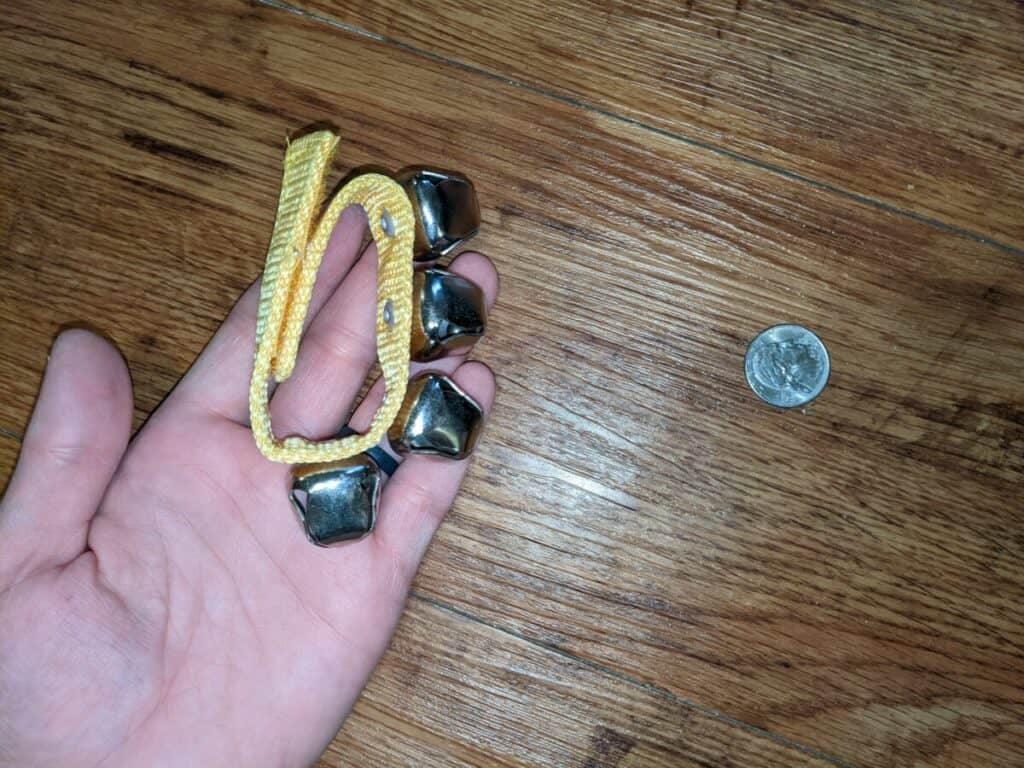
Sleigh bells are great instruments for kids. All you have to do is bounce around and you’ll make plenty of sound.
Clave
The clave is simply two pieces of wood that you strike, together. The clave is actually an essential part of many different music styles.
The sound of claves is sharp and can cut through an entire percussion ensemble–which is by design.
The clave also is the name of a critical rhythm that is also fundamental to many instruments.
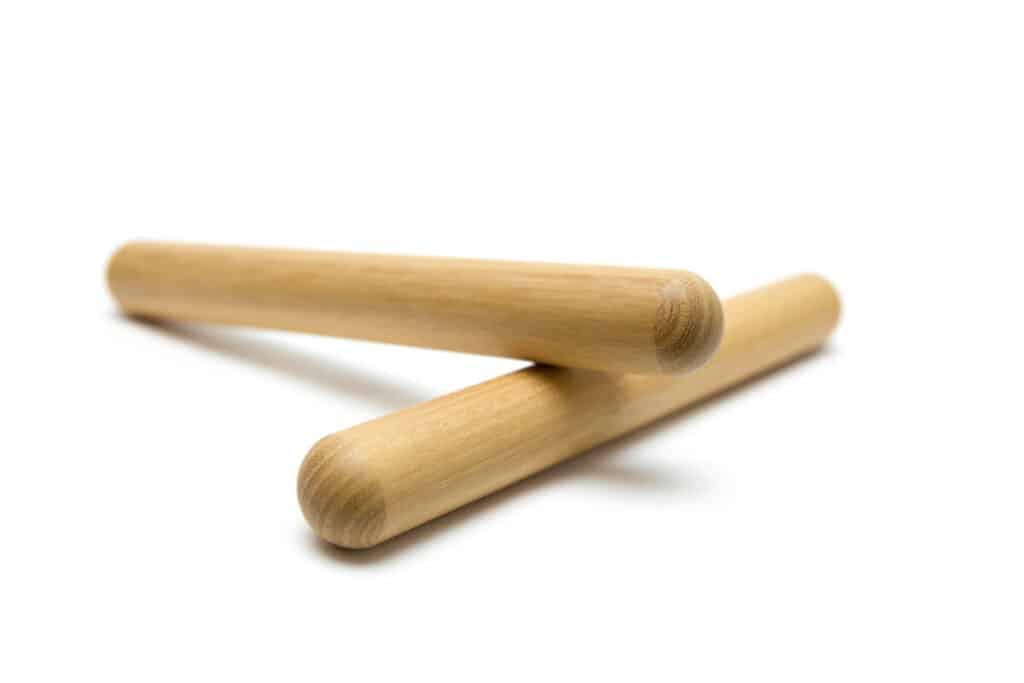
Claves are not as long as drumsticks and can fit in your pocket.
Tone Block
A tone block is a simple bit of percussion that is carved into either a cylindrical or square shape and when struck resonates with a particular tone. The size and shape of the cylinder/square all impact the sound. The tone block can be hollow to create a resonance chamber which also changes and shapes the sound.
The tone block is meant to be played with a striker or mallet.
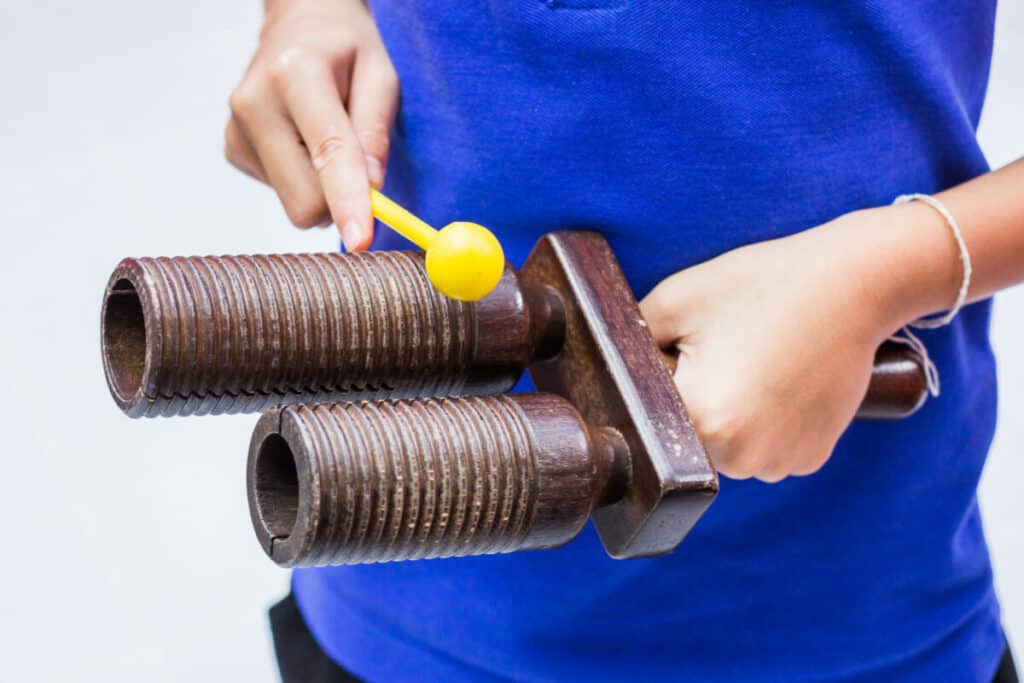
Some of these tone blocks are quite large, while others can slip into your pocket, like this one at guitarcenter.com.
Jam Block
A jam block is very similar in concept to the tone block but the main difference is that jam blocks are meant to be played with drumsticks or mallets and are often mounted.
That doesn’t mean you can’t hold a jam block and play it with a drumstick. Similar to how you would play a cowbell.
You can find an example of a jam block here at Sweetwater.
Pellet Drum
The pellet drum is called many different things but essentially is an instrument where you have two strikers attached with strings to the sides of the instrument.
The pellet drum is played by twisting the drum back and forth to whip the strikers against the drumhead. As with many other percussion instruments, they can be small or large.
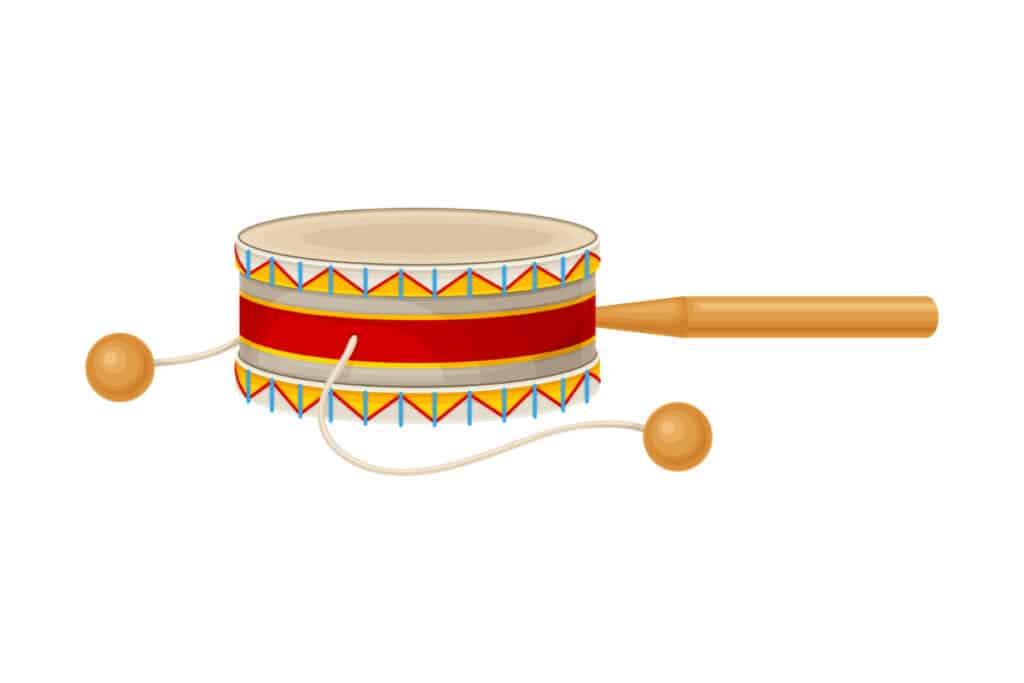
Tambourine (6-inch)
A tambourine is a frame with little metal plates that rattle against each other when shaken.
Tambourines can be pretty big but some can be as small as 6 inches.
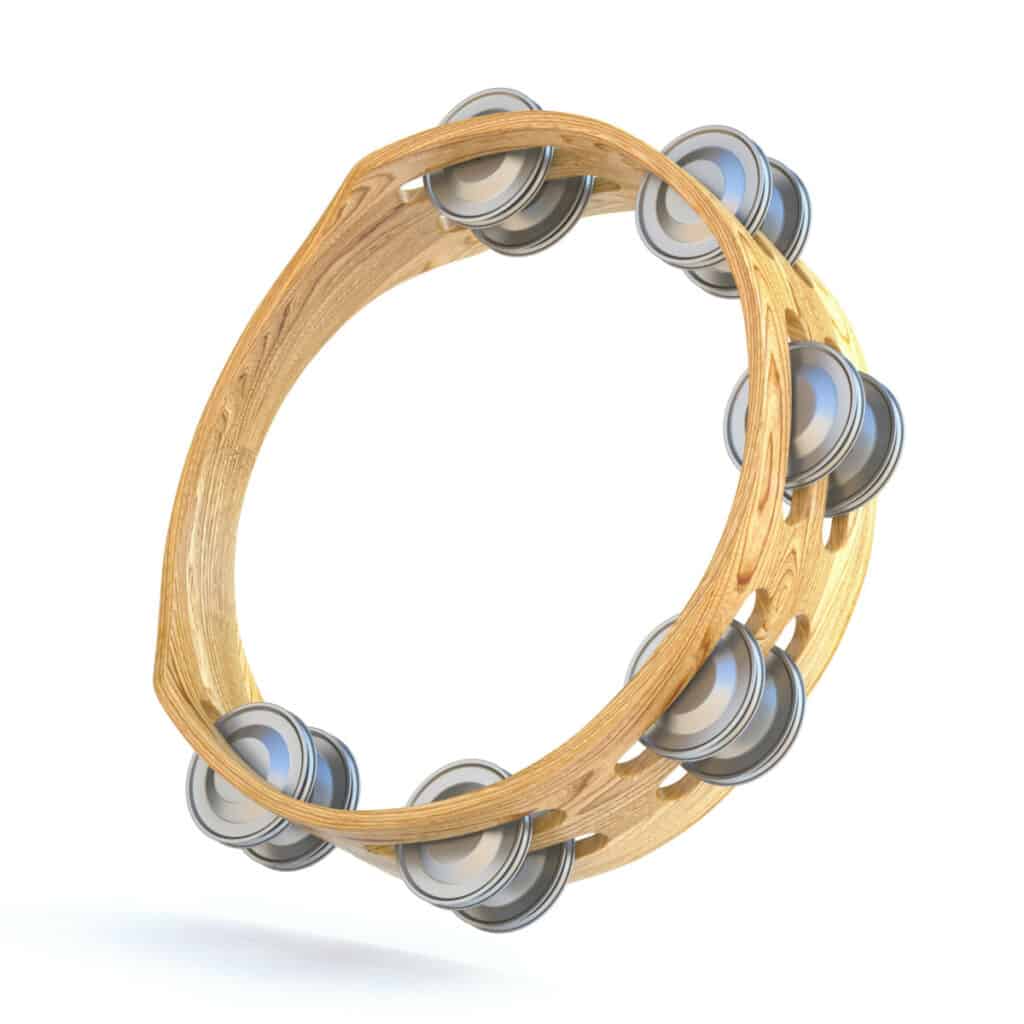
Some tambourines actually have a drumhead so you can strike the drumhead with your hand as well as shake the frame.
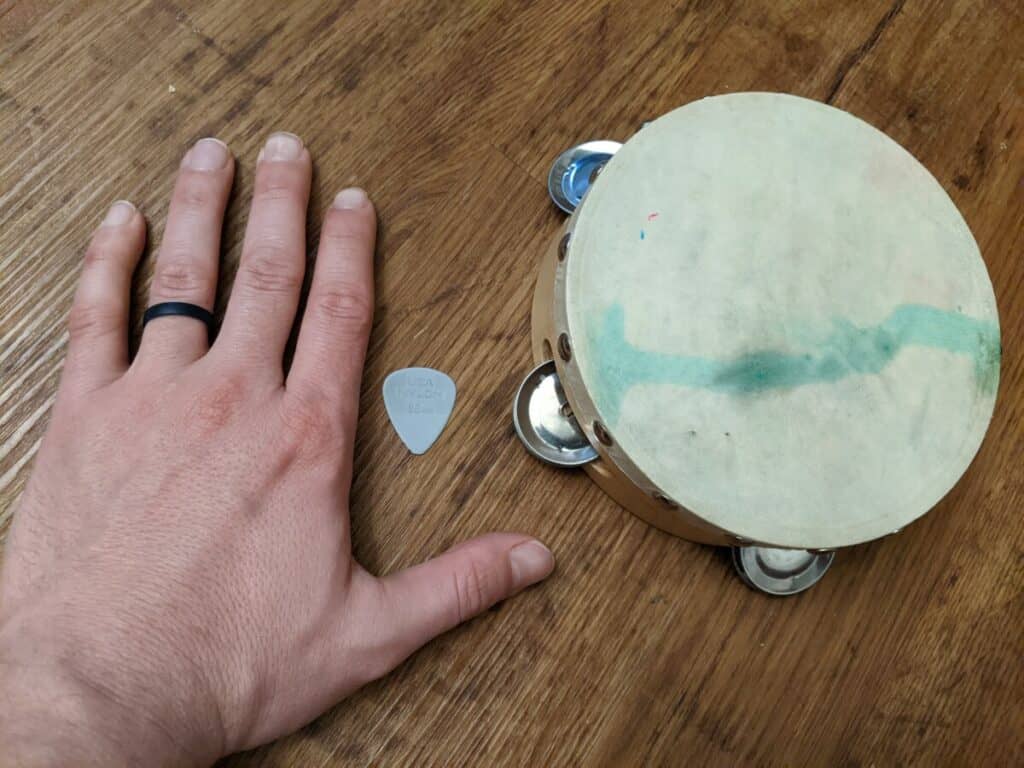
Foot Tambourine
Besides a regular tambourine (with a drumhead or headless), there are also tambourines that you can attach to your foot.
This gives players that are already using their hands the opportunity to add a tambourine to the mix.
They work by strapping the tambourine around your shoe with the cymbals on top.
You can see an example at Sweetwater, here.
Agogo
An agogo is a two-tone percussion instrument made up of two bells. Modern agogos are connected by a metal bar in a C shape.
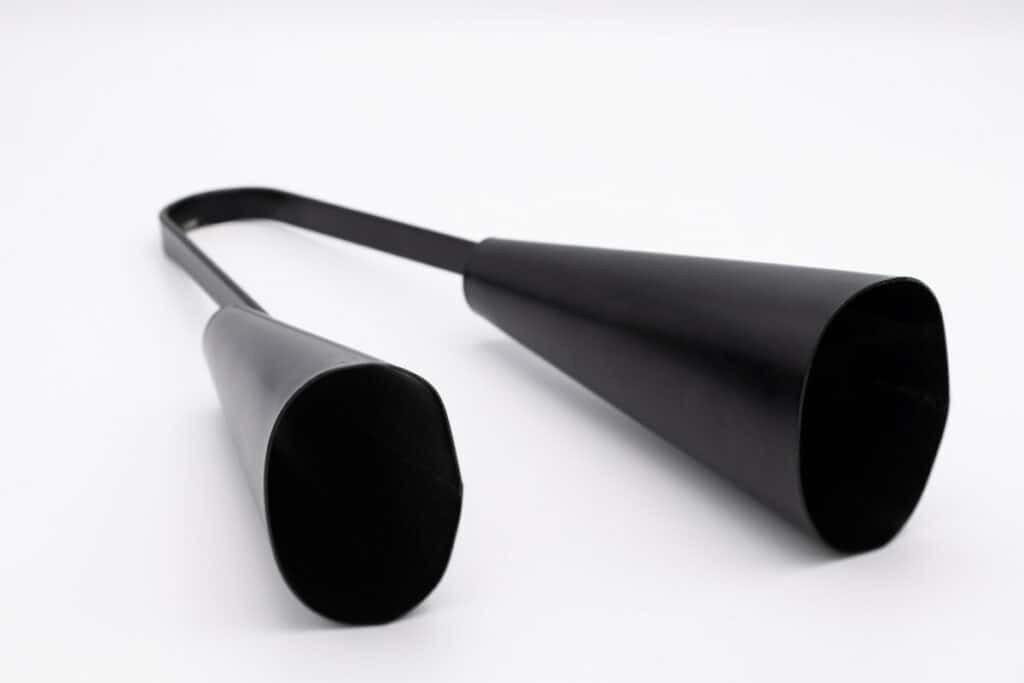
The agogo has a distinct sound and it’s meant to be played where you alternate between the two bells in particular rhythms.
As with most percussion instruments, an agogo can be large or small.
Cabasa
A cabasa can come in a lot of forms, but it’s essentially a rattle made from beads or ball bearings rubbing across ridges or a rasp of some sort.
A cabasa’s sound is similar to a shaker, but a cabasa is handy to a percussionist if you want complete control over the sound as you can rotate the cabasa precisely to make whatever sound you want whenever you want it.
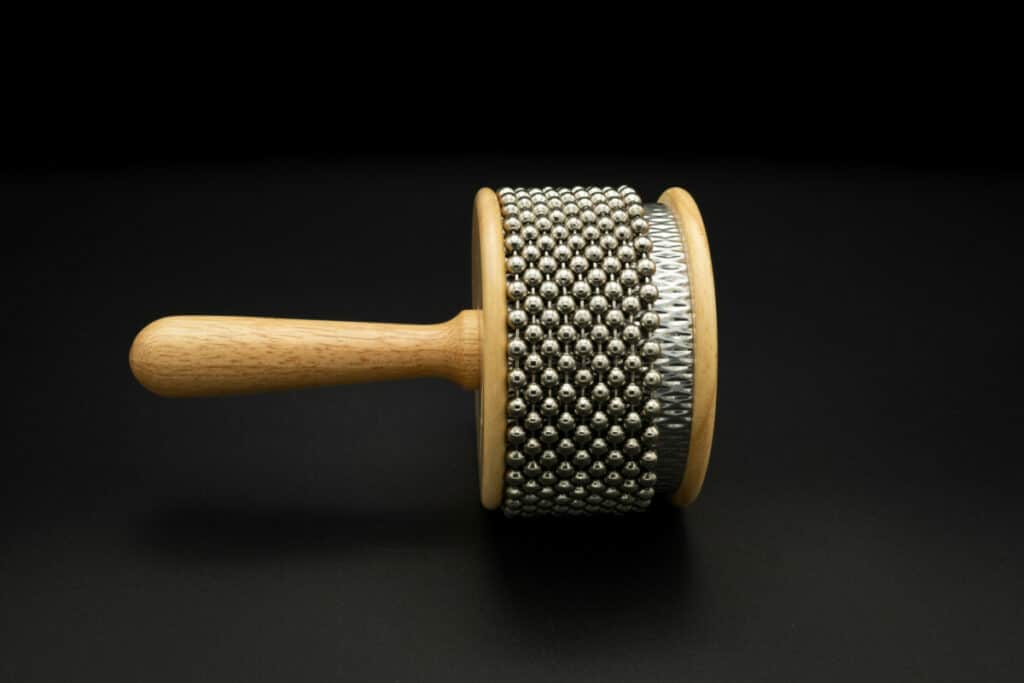
Small Cowbell
Ahh, the infamous cowbell. I know it sounds crazy, but the cowbell can add a lot to a song. It’s a dank meme by now, but more cowbell really is the best idea, sometimes.
Some cowbells are huge, actually, while others will fit in the palm of your hand.
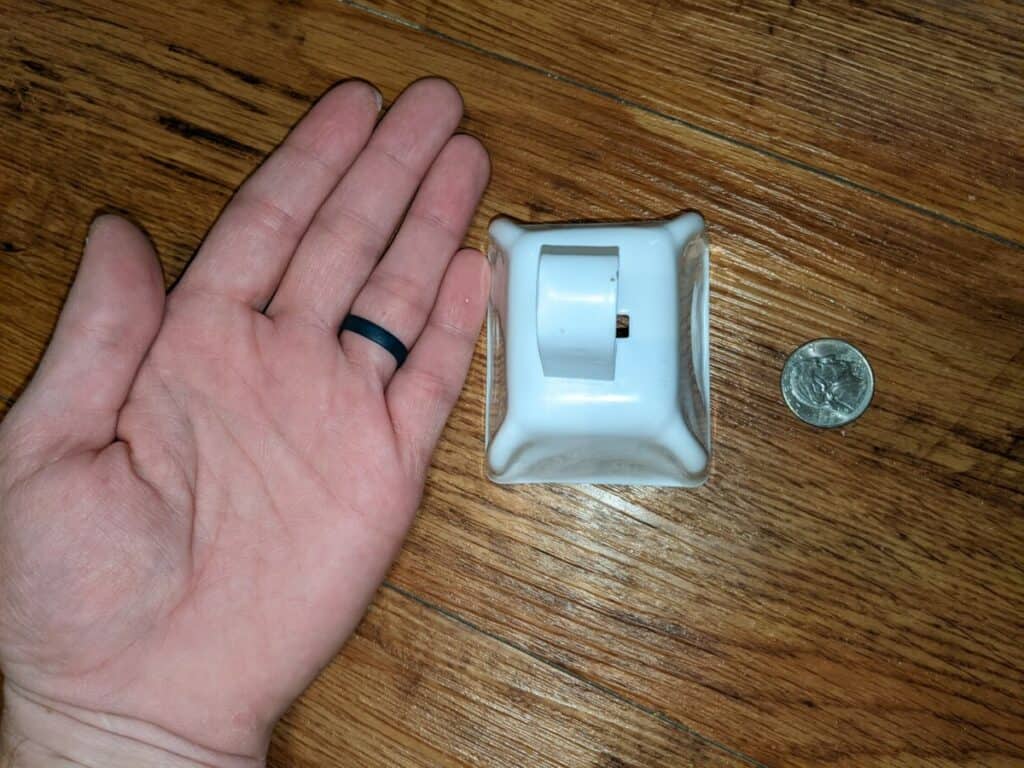
Here’s a 5-inch cowbell at Sweetwater for reference.
Small Guiro
A guiro is typically a ribbed piece of wood that your rub with another piece of wood making a sort of scratching sound.
My description is a little vague, but that’s because there are so many different types of guiros. For example, we have two of them, and one is a small guiro with no frills, but the other is a novelty guiro in the shape of a frog which when you rub the ribs the guiro sounds somewhat like a frog croaking, while yet another is carved in the shape of a cricket
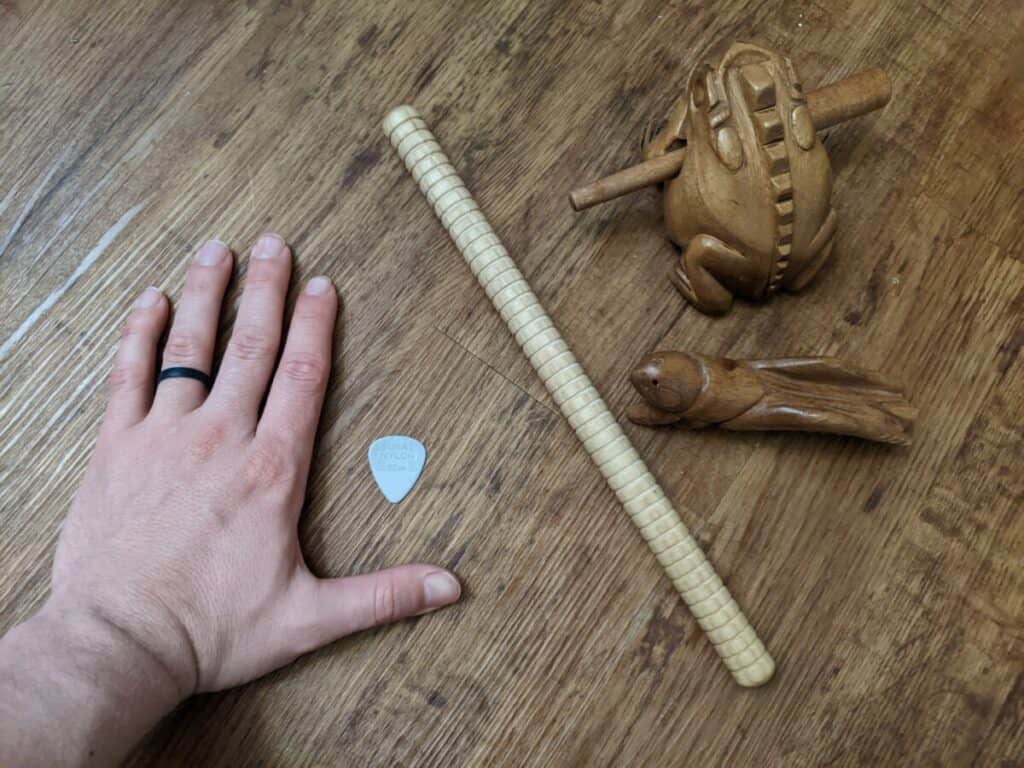
In any case, you’ll be able to find small guiros that can really add a lot to a song.
Finger Cymbals
Finger cymbals, also called Zills, make a sharp ringing sound and are versatile enough to be used while doing something completely different, like belly dancing!
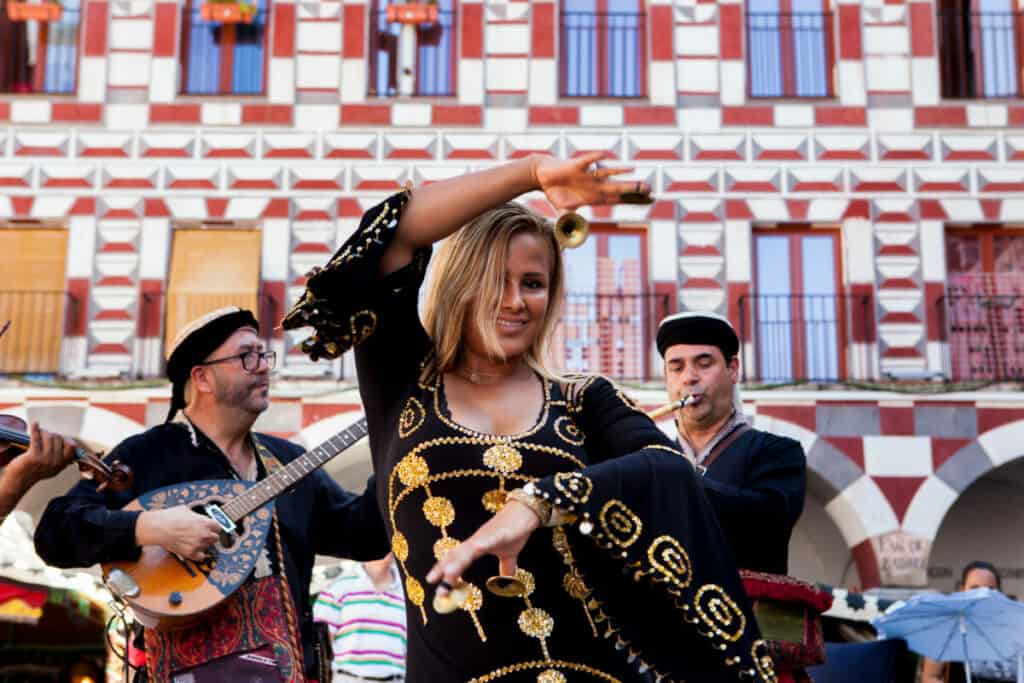
If you want to see a close up of these, you can check out some you can find on Sweetwater, here.
Runner’s Up: A Bit Too Big For Your Pocket, But Still Small
Lyre Harp
Harps are big. REALLY big. Even small harps can be big.
One special type of harp is a “lyre” harp, which is meant to have a limited note range in exchange for a smaller instrument.
This video is from Mike–I’ve gotten to talk, personally with him, and he’s a swell guy.
Compact Didgeridoo
When you think of a didgeridoo you often think of a long 3ft-5ft cylinder with a flared bell. And yes, that’s true in most cases.
However, as the designers of the trumpet found out, you can get a similar sound if you simply coil the pipe.
A compact didgeridoo can create an impressive didgeridoo sound in a compact shape. You will always be limited by physics so don’t think you can get the same volume or projection as a typical didgeridoo, but you can still make plenty of sound with a compact didgeridoo.
Pocket Trumpet
Don’t be fooled, a pocket trumpet is FAR too big for a pocket, but it is much more compact than a traditional trumpet. You could fit in a spacious backpack, for sure.
A pocket trumpet sounds like a normal-sized trumpet, but to be able to get that smaller size with the same sound, the pocket trumpet simply coils the pipes more tightly. This means that the pocket trumpet is dense with pipe and isn’t necessarily lighter than a traditionally sized trumpet.
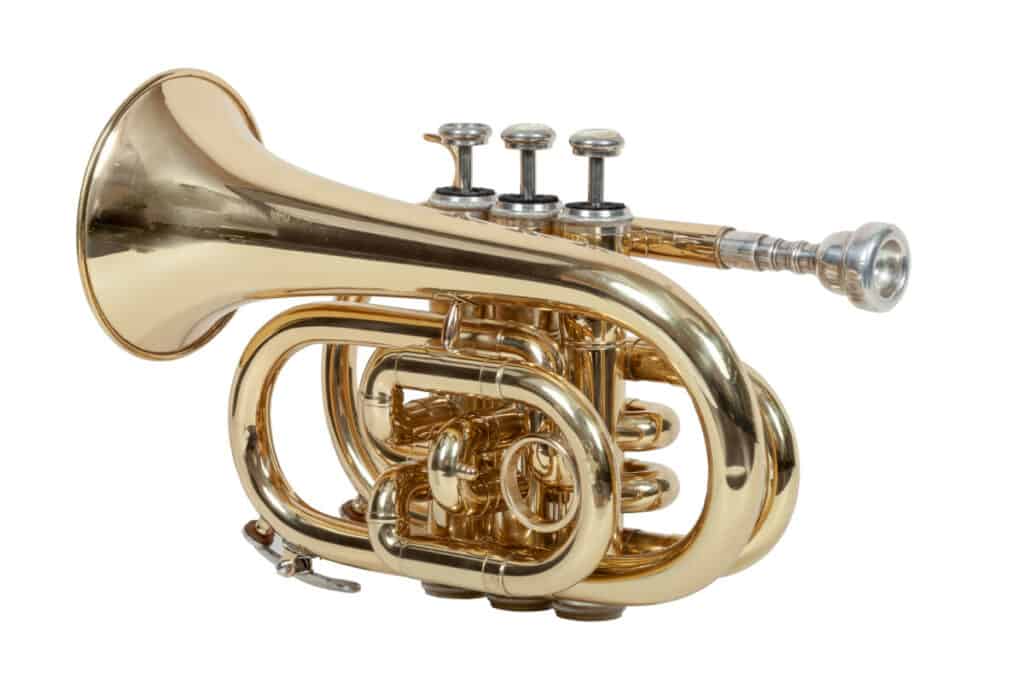
Recorder
The recorder is not as big as a clarinet, but bigger than a tin whistle. A recorder is often used in childhood music education but some pursue it as a career instrument.
